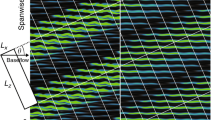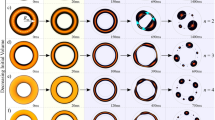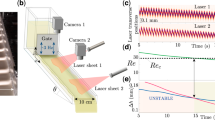The changing boundaries of a stream flowing at a constant rate are explained.
Abstract
A jet of fluid flowing down a partially wetting, inclined plane usually meanders but — by maintaining a constant flow rate — meandering can be suppressed, leading to the emergence of a beautiful braided structure. Here we show that this flow pattern can be explained by the interplay between surface tension, which tends to narrow the jet, and fluid inertia, which drives the jet to widen. These observations dispel misconceptions about the relationship between braiding and meandering that have persisted for over 20 years.
Similar content being viewed by others
Main
The flow of water down a partially wetting, inclined surface, as in rivers and streams, is affected by the substrate's roughness and by flow disturbances. This results in seemingly random height and width variations and meandering. River morphology is also influenced by soil erosion1, which is not necessarily present in the general case of flow down an inclined surface.
We observe that the meandering of a stream on a smooth, non-eroding, inclined plane is caused entirely by upstream disturbances, and meandering can therefore be eliminated, contrary to established belief2. However, the variations in the height and width of a braided stream represent an inherent instability of the stream caused by the interaction of surface tension and inertia.
To visualize the stream dynamics, a flat incline (such as an acrylic plate) can be placed under a faucet: the small fluctuations always present in tap water will cause this stream to meander. In our experiment, the meandering is eliminated by maintaining a constant flow rate; we then see a stationary braiding pattern in which the width of the stream expands and contracts as it propagates (for methods, see supplementary information).
This braiding pattern can be explained as follows. When the fluid jet strikes the inclined surface, it spreads out owing to the inertia of the impact. Most of the fluid flows at the outer boundaries of the flow, and the interior of the stream is very shallow. Surface tension limits the extent of the spreading and pulls the outer boundaries of the flow back together. In the process of contraction, the outer edges accelerate beyond equilibrium and ‘bounce’ on impact, forcing the boundaries outwards; the outer edges then collapse again because of surface tension, and the process repeats.
The amplitude of the subsequent bounces decreases owing to viscous dissipation, and far downstream the flow assumes a simple profile with a part-circular cross-section, when all the forces are in balance3,4. This structure is reminiscent of the fluid chain structure produced by two fluid jets colliding in air5, although it is different in its physics because of dissipation at the solid surface.
To explain the braiding phenomenon quantitatively, we constructed a model that assumes that the stream is shallow, the downstream velocity component dominates the flow, and the contact angle between the plate and fluid is constant (see supplementary information). Previous, more complex models6,7 do not account for the large amplitude variations that we observe. Our simple model incorporates inertial effects in flows down an inclined plane8,9 and couples two ordinary differential equations that predict both the nonlinear evolution of the braids and the transition from the braiding to non-braiding situation.
Although our assumption of a constant contact angle is an approximation10, it greatly simplifies the analysis. Figure 1 shows that the agreement between the model and experiment is excellent throughout the parameter range investigated; it also shows that the braid-length dependence on the parameters Π1 and Π2 (see supplementary information) can account for the transition to a dissipation-dominated, non-braiding flow.
a, Experimental observation of braiding flow. Parameters varied are flow rate q, inclination angle α and viscosity ν. Here q = 12.2 cm3 s−1, α = 45°, ν = 0.016 cm2 s−1. The flow also depends on surface tension, γ, and acceleration due to gravity, g. Red line indicates agreement with theory. Scale in centimetres; flow direction is left to right. b, Experimentally observed braiding (filled circles) and non-braiding (open circles) flow represented by the dimensionless parameters Π1 and Π2, where Π1 = 1/2νρ7q5(gsinα)4γ−7 and Π2 = 1/2νρ2q(g sinα)γ−2. Solid line, theoretical transition boundary from non-braiding to braiding flow; dashed line, power-law fit Π2 = 1.53 Π11.89.
References
Ikeda, S., Parker, G. & Sawai, K. J. Fluid Mech. 112, 363–377 (1981).
Nakagawa, T. & Scott, J. J. Fluid Mech. 149, 89–99 (1984).
Davis, S. H. J. Fluid Mech. 98, 225–242 (1980).
Perazzo, C. A. & Gratton, J. J. Fluid Mech. (in the press).
Hasha, A. & Bush, J. W. M. Phys. Fluids 14 (suppl.), 8 (2002).
Weiland, R. H. & Davis, S. H. J. Fluid Mech. 107, 261–280 (1981).
Young, G. W. & Davis, S. H. J. Fluid Mech. 176, 1–31 (1987).
Bohr, T., Putkaradze, V. & Watanabe, S. Phys. Rev. Lett. 79, 1038–1041 (1997).
Lopez, P. G., Miksis, M. J. & Bankoff, S. G. Phys. Fluids 9, 2177–2183 (1997).
DeGennes, P. G. Rev. Mod. Phys. 57, 827–863 (1985).
Author information
Authors and Affiliations
Corresponding author
Ethics declarations
Competing interests
The authors declare no competing financial interests.
Supplementary information
Supplementary Methods
(PDF 36 kb)
Supplementary Equations
(PDF 44 kb)
Rights and permissions
About this article
Cite this article
Mertens, K., Putkaradze, V. & Vorobieff, P. Braiding patterns on an inclined plane. Nature 430, 165 (2004). https://doi.org/10.1038/430165a
Published:
Issue Date:
DOI: https://doi.org/10.1038/430165a
This article is cited by
-
Meandering instability of air flow in a granular bed: self-similarity and fluid-solid duality
Scientific Reports (2016)
-
Experimental investigation of inclined liquid water jet flow onto vertically located superhydrophobic surfaces
Experiments in Fluids (2010)
Comments
By submitting a comment you agree to abide by our Terms and Community Guidelines. If you find something abusive or that does not comply with our terms or guidelines please flag it as inappropriate.




